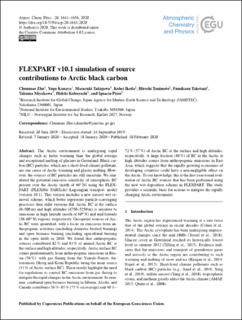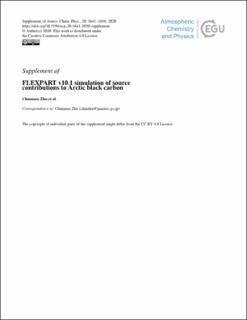| dc.description.abstract | The Arctic environment is undergoing rapid changes such as faster warming than the global average and exceptional melting of glaciers in Greenland. Black carbon (BC) particles, which are a short-lived climate pollutant, are one cause of Arctic warming and glacier melting. However, the sources of BC particles are still uncertain. We simulated the potential emission sensitivity of atmospheric BC present over the Arctic (north of 66∘ N) using the FLEXPART (FLEXible PARTicle) Lagrangian transport model (version 10.1). This version includes a new aerosol wet removal scheme, which better represents particle-scavenging processes than older versions did. Arctic BC at the surface (0–500 m) and high altitudes (4750–5250 m) is sensitive to emissions in high latitude (north of 60∘ N) and mid-latitude (30–60∘ N) regions, respectively. Geospatial sources of Arctic BC were quantified, with a focus on emissions from anthropogenic activities (including domestic biofuel burning) and open biomass burning (including agricultural burning in the open field) in 2010. We found that anthropogenic sources contributed 82 % and 83 % of annual Arctic BC at the surface and high altitudes, respectively. Arctic surface BC comes predominantly from anthropogenic emissions in Russia (56 %), with gas flaring from the Yamalo-Nenets Autonomous Okrug and Komi Republic being the main source (31 % of Arctic surface BC). These results highlight the need for regulations to control BC emissions from gas flaring to mitigate the rapid changes in the Arctic environment. In summer, combined open biomass burning in Siberia, Alaska, and Canada contributes 56 %–85 % (75 % on average) and 40 %–72 % (57 %) of Arctic BC at the surface and high altitudes, respectively. A large fraction (40 %) of BC in the Arctic at high altitudes comes from anthropogenic emissions in East Asia, which suggests that the rapidly growing economies of developing countries could have a non-negligible effect on the Arctic. To our knowledge, this is the first year-round evaluation of Arctic BC sources that has been performed using the new wet deposition scheme in FLEXPART. The study provides a scientific basis for actions to mitigate the rapidly changing Arctic environment. | en_US |


